Physical Address
304 North Cardinal St.
Dorchester Center, MA 02124
There is an increasing role for imaging in the planning and performance of biopsy procedures. It is generally deemed unacceptable in modern practice to perform ‘blind’ biopsies on anything other than the most superficial lesions when imaging can provide real-time monitoring of biopsy needle position. Image-guided biopsies improve diagnostic accuracy and reduce complication rates. Ongoing technological advances are providing us with new and improved imaging modalities to aid biopsy and there are a number of modality fusion techniques, which promise to further improve lesion targeting in the future.
Percutaneous image-guided needle biopsy is currently a standard technique for the diagnosis of most tumours throughout the body and also has a role in the diagnosis of certain infective and inflammatory conditions. It is particularly helpful in the staging of cancer, most notably when the definitive treatment may not involve surgical intervention. Advances in imaging techniques have led to greater precision in the targeting of lesions. Advantages of percutaneous biopsy over surgical excision biopsy include time and cost savings and reduced morbidity. The complication rates associated with percutaneous biopsy vary according to the organ studied but are generally lower than 0.1%.
Most image-guided biopsies can be performed using local anaesthesia and/or sedation. General anaesthesia may be preferable in some patients, including children. Pertinent patient history includes bleeding diatheses and anticoagulant use. Contraindications to biopsy include an uncorrected coagulopathy and lack of a safe needle approach route. The benefits of confirming a suspected diagnosis need to be evaluated against the inherent procedural morbidity.
Preprocedural assessment aims to reduce complication rates by optimising the patient's physiology and identifying contraindications in a timely fashion. It is also useful in alleviating patient anxiety and discussing postprocedural care to enable the patient to plan time off work, if required. The preprocedural assessment is also a good time to obtain patients’ written consent.
Careful questioning can determine whether a day case procedure is appropriate, taking into account the patient's clinical status and home circumstances. Any language, cultural or religious barriers can also be identified. Regularly updated and referenced departmental patient information leaflets should be available for all common procedures and include links to web-based information and relevant telephone numbers for further advice. These help to inform the consent process and provide postprocedural advice because it is well documented that patients retain little of any verbal information imparted to them.
Another role of preprocedural assessment is to highlight potential problems related to patient comorbidity or the nature of the biopsy target. If the patient is on anticoagulants or has a coagulopathy, the timing of the biopsy procedure should be carefully planned around the cessation of anticoagulant medication or admission for correction of coagulation disorders. These patients have an increased risk of postprocedural haemorrhage and may require an extended period of observation. The nature of the target lesion also requires consideration as vascular lesions are at an increased risk of bleeding; it may be necessary to establish peripheral venous access and ensure the availability of cross-matched blood. Wherever possible, an obstructed organ should be decompressed prior to biopsy using techniques such as biliary drainage or percutaneous nephrostomy.
Patients should be told how and when they will receive biopsy results and a follow-up outpatient clinic appointment booked prior to discharge.
Fine-needle aspiration (FNA) uses a small-calibre needle (20 to 25 G) to obtain a sample of cells from a target organ/lesion for cytological analysis. Core biopsy involves larger-calibre needles (14 to 19 G) and reveals more structural information, which is often necessary for histological diagnosis ( Table 81.1 ). There are also methods of collecting a cell block from an FNA sample, allowing immunohistochemistry analysis and hence more accurate cytological diagnosis in some tumour types. Each method has its own advantages and disadvantages, and the decision as to which one to use depends on many factors discussed later.
| Needle Gauge | Diameter (mm) |
|---|---|
| 22 | 0.72 |
| 21 | 0.82 |
| 19 | 1.10 |
| 18 | 1.26 |
| 16 | 1.67 |
| 14 | 2.13 |
FNA with a small-calibre needle may be used in situations where a structure (e.g. bowel loop) needs to be transgressed if it is interposed between the target lesion and skin. Similarly, where a deep lesion lies in close proximity to critical vascular structures (e.g. a central liver lesion abutting the vena cava), core biopsy may be deemed too hazardous.
Aside from the reduced risk of iatrogenic injury, FNA can be useful in frail or unwell patients who cannot tolerate a prolonged procedure. A further advantage is that cytological slides can be examined immediately to check for adequacy and formal pathology reports can be issued rapidly if required. This is particularly useful in the setting of a ‘one-stop’ clinic (e.g. neck lumps) whereby patients can be clinically assessed, undergo ultrasound-guided FNA and receive a provisional result and management plan during a single outpatient visit.
The degree of confidence in cytological diagnosis will vary according to the indication; the diagnosis of recurrent malignancy can be more easily made on a cytological sample if previous tumour tissue is available for comparison. However, for a new diagnosis of malignancy, a larger sample of tissue is usually required, and hence core biopsy is generally preferred over cytology. This is particularly important where different subtypes of malignancy exist (e.g. lymphoma), and accurate histological typing is necessary to plan treatment. Other pathologies requiring histological confirmation include diffuse disease such as hepatic cirrhosis and renal parenchymal disease (e.g. glomerulonephritis).
Needles vary in calibre, tip design, length and mechanism of action, and there are a wide range of different products on the market. Needle choice depends on a number of factors including the lesion to be targeted, the number of cores required, the modality chosen for image guidance, personal preference, cost and local availability. They can be broadly classified as follows.
Cytological samples are usually taken with small-calibre needles (20 to 25 G). Different lengths of small-calibre needle are available and the needle should be carefully selected according to the depth and size of lesion to be sampled. For abdominal FNA, the target will often be deep and a spinal or other stylet needle is often used. The presence of a needle stylet helps to avoid luminal contamination with tissue before it reaches its target. When using very fine needles, a stylet also aids insertion by stiffening the needle to prevent course deviation.
For core biopsy, larger-calibre cutting needles are used (usually 16 to 18 G for abdominal biopsies). The size of biopsy needle chosen depends on the organ being targeted and may also vary according to the number of samples being obtained. For a routine ‘background’ liver biopsy, a single pass is usually sufficient and so a larger (e.g. 16 G) biopsy needle may be chosen. If the operator anticipates that several cores will need to be obtained (e.g. in the case of multiple lesions), then a 20-G needle may be more appropriate to reduce the risk of bleeding following multiple liver capsule punctures.
The shape of the tissue core obtained varies according to the design of the chamber within the biopsy needle; various manufacturers have designed biopsy instruments which optimise the volume of tissue obtained for a given needle gauge because there is evidence that increasing needle calibre is related to increased risk of haemorrhage.
Some biopsy instruments allow placement of the central notch at the exact position required and then the cutting sheath is fired over the stylet ( Fig. 81.2 ). There is therefore no additional forward excursion of the needle upon firing the cutting part of the needle, so minimising the risk of damage to adjacent structures. This is useful in the case of small lesions or those adjacent to critical structures such as large veins. However, when the target tissue is fibrous or very firm in texture it can be difficult to manually advance the cutting needle through the lesion without displacing it. This is often overcome by the use of spring-loaded, fully automated devices that exert more forward force to advance the needle into the target.
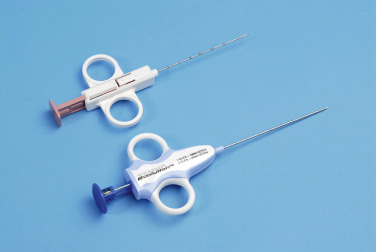
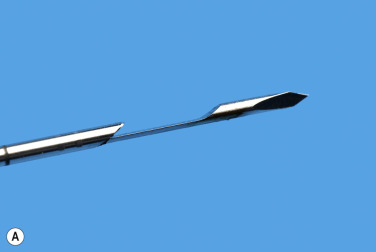
These take the form of fully disposable integrated plastic biopsy devices, which fire both a central stylet and cutting sheath in a rapid forward motion such that the tissue core is obtained at a preset distance or ‘throw’ (e.g. 2 cm) ahead of the visualised needle tip. Many of the instruments offer a choice of throw (usually 1 or 2 cm) depending on the size of target lesion or organ. This mechanism of action means that the operator needs to be aware of the size of the lesion to be sampled relative to the throw of the biopsy needle. Often the needle tip can be positioned at the superficial margin of the target lesion to avoid injury to adjacent structures.
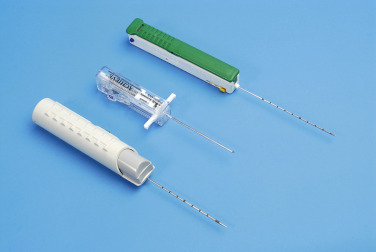
These operate using a suction mechanism but are no longer in common use. They are based on the Menghini principle in which the needle, stylet and syringe form a single unit.
Most biopsies are performed by making one or more passes into an organ or mass with a single biopsy needle. Occasionally it may be helpful to use a system whereby a coaxial needle is radiologically guided into the lesion/mass, the central stylet is removed and then a smaller-calibre biopsy needle can be inserted through the coaxial system to obtain multiple cores ( Fig. 81.4 ). This has the advantage of allowing several samples to be taken without repuncturing the superficial soft tissues or organ capsule, which theoretically reduces the risk of haemorrhage and the time taken to target the lesion, although studies have not demonstrated any significant difference in complication rates between coaxial and noncoaxial techniques. The coaxial needle can be angled between samples to increase the volume of tissue sampled. This technique is commonly used during computed tomography (CT)-guided biopsy, particularly for lung lesions where minimising the number of passes through the pleura reduces the risk of pneumothorax ( Fig. 81.5 ). It is also used for biopsy of deep abdominal/pelvic masses because it reduces the radiation dose and the trauma involved in repositioning biopsy needles for each core. There is also a theoretical advantage that coaxial systems reduce the risk of track seeding. A disadvantage is that the calibre of the coaxial needle must be larger than that of the biopsy needle, increasing the overall size of the needle track, with a possible increased risk of damage to adjacent tissues.
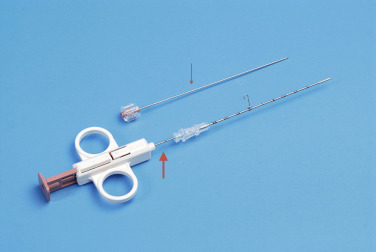
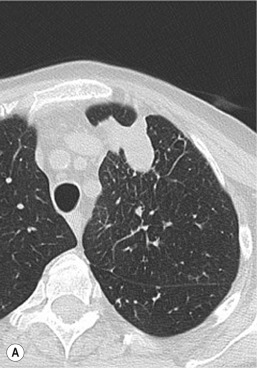
The choice of imaging modality for biopsy varies according to the size, location and visibility of the lesion. Most lesions can be approached using either ultrasound or CT imaging, and these are the workhorses of standard radiology practice. Other modalities are useful in different situations, as outlined later. Modern technology and software can allow a combination of modalities to be used during biopsy procedures (fusion imaging) to aid targeting of lesions (e.g. real-time ultrasound superimposed on previously acquired diagnostic CT images). This technique is being increasingly used to increase accuracy at challenging biopsy sites.
Ultrasound-guided biopsy is considered to be an accurate, safe, widely accessible and relatively cheap technique. It has the advantage of real-time visualisation of the needle (particularly important for biopsy of organs such as the liver where the time the biopsy needle remains within the liver parenchyma should be limited to minimise haemorrhagic complications). In addition, it allows a multiplanar angled approach that may be more challenging if CT or magnetic resonance imaging (MRI) is used. Ultrasound-guided biopsy procedures have the advantages of portability and lack of ionising radiation. However, ultrasound-guided biopsies are more operator-dependent than procedures guided by other imaging modalities. Modern ultrasound platforms and software are becoming increasingly advanced, enabling the operator to benefit from additional information to aid lesion targeting. Intravenous ultrasound contrast agents and elastography data can also be used to aid the accuracy of biopsy procedures.
Technology which enables coregistration of real-time ultrasound imaging with CT/MRI studies is being increasingly used. One example of this is using previously acquired MRI data to aid ultrasound-guided prostate biopsy. It can be difficult to identify focal prostatic lesions at ultrasound, and cancers may be missed despite methods that allow a large number of biopsy cores to be acquired. Fusing preprocedural MRI data with real-time transrectal ultrasound (TRUS) imaging combines the advantages of each modality by allowing the biopsy needle to be introduced into suspicious lesions in the prostate previously identified with MRI but under real-time TRUS guidance. CT and ultrasound fusion can be used to equally good effect, notably in lesions that are difficult to fully delineate on ultrasound but the latter is the safest way to perform the procedure: for example, with liver lesions where a single pass through the capsule during a breath-hold minimises the risk of postprocedural haemorrhage.
CT is generally preferred for biopsies of the lung, bone and deep structures where ultrasound visualisation is poor. CT-guided techniques can be extremely accurate with appropriate lesion selection and an experienced user. However, access to scanning time and radiation dose are limiting factors. In addition, nonfluoroscopic CT techniques are not ‘real time’, because needle position is checked after each adjustment. This theoretically carries a greater risk of damaging local structures compared with true real-time techniques. CT fluoroscopy technology enables biopsies to be performed under real-time CT imaging. This is useful for more challenging procedures (e.g. small target lesions) and may be performed with relatively small radiation doses. CT fusion techniques (e.g. with ultrasound) are increasingly used as discussed elsewhere.
Up-to-date MRI scanners and MRI safe equipment have made this a promising technique for image guidance, although it is still not commonly used. It is particularly useful where an oblique approach is required (e.g. for subdiaphragmatic liver and adrenal masses) or when the lesion is only detectable on MRI sequences. MRI provides improved soft-tissue detail when imaging certain organs and structures compared with CT or ultrasound and hence can be invaluable in targeting lesions in areas such as the prostate gland ( Fig. 81.6 ).
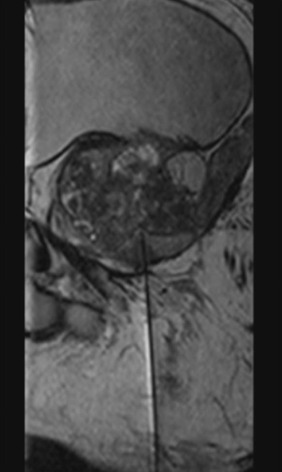
MRI-guided breast biopsies are more routinely performed, mainly for lesions that are difficult to localise with mammography or ultrasound. Within the field of musculoskeletal imaging, MRI-guided biopsy is useful for lesions in the bone marrow that cannot be identified by CT. The main disadvantage of MRI-guided biopsies is the magnetic environment, which limits equipment use, making some procedures more complex. This in turn can lead to increased procedural times which may be an issue where magnetic resonance (MR) resources are limited. There are also increased costs to consider, and patients may find MRI-guided procedures more uncomfortable due to positioning constraints. Open magnets allow direct access to the patient during the entire procedure, enabling real-time monitoring of needle insertion. A further problem with MRI-guided biopsy is the need for motion correction during the biopsy procedure. In addition, patients may not be able to tolerate MRI due to claustrophobia or have other contraindications such as pacemakers. MRI-safe biopsy equipment is currently mass produced but is expensive and the range is limited. The use of MRI guidance is likely to increase, but these limitations will continue to make this an infrequently used modality for biopsy.
Become a Clinical Tree membership for Full access and enjoy Unlimited articles
If you are a member. Log in here